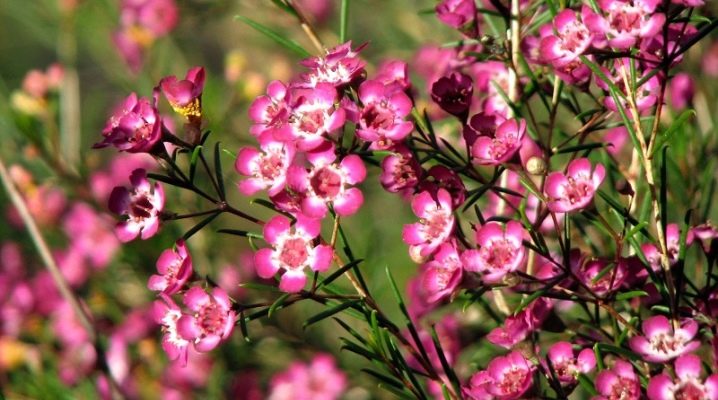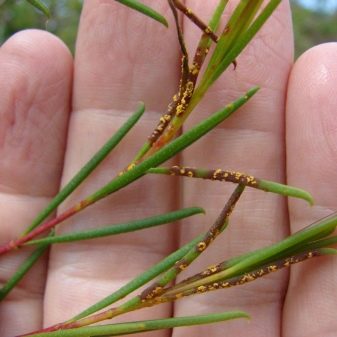Hamelacium and its cultivation

The features of chamelacium, its cultivation and flower care at home are not well known to a wide range of flower growers. And at the same time, even planting it is different from working with other flowering plants. It is necessary to find out what constitutes white wax myrtle and snowflake, waxflower and other plant species.


general description
A rare plant does not have several names at once - and chamelacium is no exception. Among gardeners, he may also be known by the names:
- gristle;
- wax myrtle;
- shamelcium;
- heraldon.
It should be noted right away that it is a typical perennial growing in shrub form... Its foliage has a needle-like appearance. The skin of these leaves is waxy (hence the characteristic epithets). There are a lot of flowers in a certain season, and they are all very fragrant.
Chamelacium is not just one species, but a whole genus of up to 14 varieties.


According to the generally accepted systematics, this genus belongs to the myrtle family; all of its representatives in nature grow in the west of Australia. These are evergreens, reaching heights of 0.5 to 3 m. Given the aridity of the original area, it is hardly surprising that the branched root system goes deep into the ground. Young branches are covered with gray-green bark. After lignification, they will be rough and brown in color.
The length of the leaves reaches 40 mm. When rubbed, they give off an attractive aroma that they owe to essential oils. Chamelacium reaches the budding stage in February. Flowering ends in May or June. The flowers themselves in various species of this genus are white or pink in color, and their center may differ:
- burgundy;
- purple;
- magenta.


The flowers themselves are of the axillary type and are always solitary. They consist of 5 petals. The fruits of the plant are juicy berries, densely grown together with the receptacle, having the shape of an ellipse or a circle. Normally, such berries are black and blue, with a waxy coating and containing up to 15 seeds. Reproduction is possible by seeds, cuttings, and by grafting. In addition to the Australian territory, chamelacium is found in Mexico and Guatemala. You can see it:
- to the wasteland;
- in the forest;
- on rocky or sandy ground.
The name heraldon appeared earlier than other names. The first botanical description of the genus was given in 1819 by René Luis Defontaine. Where did the term chamelacium come from, even specialists could not find out. But they found that the plant itself serves as an indicator of a change in the weather. If rain is coming, its flowers will be closed.


Types and varieties
- Notable for the hooked chamelacium... He has a consistently lush crown. It is held very stable. The total height can reach 200 cm. The plant is actively developing young parts, and from the older ones it will invariably fly around "needles".

- Hamelacium white Is a culture that visually resembles a small Christmas tree. The leaves are colored in a rich green tone. They are quite long. During flowering, the formation of both white and slightly pinkish buds is possible. They are sometimes compared to bells.

- It is also attractive snowflake... Its bushes grow up to a maximum of 40 cm. This type gives, again, white and pink flowers. It is actively used by the composers of bouquets. It is also used for ikebana.

- Term waxflower can be applied to any chamelaciums - in fact, it is just a synonym. The Early nir variety produces lilac-pink flowers.It is believed that this is one of the subspecies of the hooked plant. The flower section is from 10 to 15 mm. The leaves are dark green in length, reaching 20-30 mm and have a sharp tip.

- Variety Rotem practically unknown, there is no normal information about him. The type of Adi is better known. Its features:
- leaves 1-2 cm long needle-shaped;
- lack of a special smell;
- purple color.

- Hamelacium Ophir looks gentle and graceful. It is a rounded plant with a large number of thin shoots covered with brownish bark. Its needle-like leaves are closer in appearance to needles. The flowers develop 5 rounded petals. The flowers themselves are white, but their middle is colored greenish or yellow.

- Hamelacium Darwinia - ornamental shrub up to 0.5 m. Its flowers are close in appearance to apple blossom. Their color varies widely. This culture is great for any garden. Most often it is planted in the sand.

- Variety Matilda stands out for its special color. When the bud opens, it will be white. Only the edge of the petal is distinguished by a beautiful pomegranate tone. In the future, Matilda will only become more saturated, until the surface of the petals is completely colored. It is a compact shrub plant with high frost resistance.

Landing
Since the roots of chamelacium are powerful, it can only be grown in a fairly large pot. Its depth is even more important than its width. Loose soil is recommended. It will have to be additionally loosened and slightly moistened. Permeability to water and air should be as high as possible. Chamelcium is preferably planted during the spring months. A large amount of light is very important to him. Using seeds for planting is not too smart, you will need to wait too long.
If seed propagation is still chosen, peat will have to be used; seeds are placed with a margin to compensate for poor germination. Shoot cultivation is easier and more practical. A branch is carefully cut off the plant itself. It is placed in a tank of water. The sprout should be covered by 10-20 mm. The container itself is placed where there is a lot of light.
Then you have to wait for the roots to appear; this is a sign that it is time to transplant the plant into the ground and cover it with a film, and the established twig is suitable for full-fledged breeding.


Care
Watering
With the onset of spring, until autumn, the earth needs to be moistened regularly. Do it abundantly. An overdried clod of earth is a sure sign of the imminent loss of foliage and the death of the bush. Worst of all, even when the roots die, everything will look decent on the surface for a while. Drying of the soil 1 cm deep from the surface is critical.
Important: watering too much is also not worth it. In autumn, irrigation is reduced, but the substrate continues to maintain a constant moderate moisture content. It is necessary to use only thoroughly settled soft water brought to room temperature. Adding small amounts of acetic or citric acid is encouraged. An alternative solution is to use distilled water, and in ecologically safe areas - collection of snow and rain.

Transfer
At home, this procedure is carried out using the transshipment method. The clod of earth must not be destroyed. The work is carried out after filling the allotted volume of soil with roots. Sometimes, in order to extract the whole coma, you even have to beat or cut the container. In a new pot, 2 cm of expanded clay or moderately large pebbles are poured; it is necessary to make holes in the bottom of the flowerpot so that moisture flows out.
The transplant soil is chosen with optimal permeability to air and water. A loosened light mass with low acidity is preferred. The addition of sliced sphagnum or some hydrogel helps to improve water retention. The main substrate is created from:
- 3 lobes of sod;
- 1 share of leafy land;
- humus soil;
- washed coarse river sand.


Top dressing
It is necessary to lay fertilizers from spring to autumn. The intervals between dressings are from 21 to 30 days. Do not use preparations containing lime. As soon as the gristle began to grow actively, it will be necessary to lay nitrogen-potassium mixtures. At the beginning of budding, the concentration of potassium and phosphorus is increased.
The dose is reduced by 50% compared to the recommended level. Due to the refusal of fertilizers during the flowering period, the buds are likely to dry out. In winter, feeding is completely stopped. In exceptional cases, they are laid, but extremely rarely, and in micro doses. Better not to risk it at all.

Pruning
You can work with the crown at the end of flowering. It is assumed, in addition to wilted buds, to also remove some of the branches. Cutting of shoots up to 20-40 mm is allowed. Exposing old stems activates branching, and new branches will appear in large numbers. On young shoots, pinching leads to more dense branching; chamelacium survives the cutting of branches well, which allows you to give it any chosen configuration.

Wintering
This moment, too, cannot be ignored when growing chamelacium. The dormant period covers November, December, January and February. For this time, the plant must be kept at 10-12 degrees. The duration of daylight should be at least 12 hours; the lack of light is compensated by phytolamps. Every 10-14 days, the culture is watered moderately. Already with the onset of autumn, the chamelacium should be moved to a cooler than usual place. There should be about 15 degrees.
Cool wintering will ensure a spectacular lush bloom afterwards. Watering in winter should be moderate. Its frequency can also be reduced. During the normal growing season, chamelacium should be placed in bright sunlight. South, west or east windows are optimal. It must be understood that at the height of daylight hours a lot of harmful ultraviolet radiation comes in, and you will have to defend yourself from it.

As soon as a stable warmth comes, the plant begins to be taken out into the open air, even into the garden. With a lack of backlighting in the summer, problems are inevitable. The optimum summer temperature ranges from 20 to 25 degrees. Even in winter, it cannot drop to less than 8 degrees. The stability of temperature indicators is also important. It is advisable to guarantee a stable supply of fresh air during warming. However, drafts are still unacceptable.
Air humidity for chamelacium does not play a fundamental role. The culture survives growing in dry air very well. Moreover, an increase in atmospheric humidity leads to rotting.

Reproduction
The scions are also suitable for breeding chamelacium. Processes longer than 15 cm are needed. All sections are sprinkled with crushed activated carbon. They need to be dried additionally. The tanks are filled with a combination of peat, leafy soil and sand. The planted shoots are covered with foil and kept warm. Humidification and airing should be done regularly. After rooting, the planting material is placed in a slightly larger tank. You will have to wait for flowering from 2 to 3 years.
Seed breeding is possible using store planting material. Put it in peat. The seeds are buried in it a little. Breeding should take place at a temperature of at least 22 degrees; the substrate is ventilated and moistened from time to time. The picking of the seedlings is carried out after 3 months, and the planting to the final place is carried out after a year; you can wait for flowers from 4 to 6 years.



Diseases and pests
Since chamelacium is rich in essential oils, it will hardly hurt. But there is no immunity to late blight at all. It can appear against a background of increased dampness. You can suppress the pathology with the help of fungicides. During the growing season, aphids are dangerous.
Gray rot is very dangerous for this plant. It can occur against the background of a combination of high temperature and significant air humidity. Fungicides help suppress gray rot.Pests for chamelacium are almost not dangerous.









































































































The comment was sent successfully.